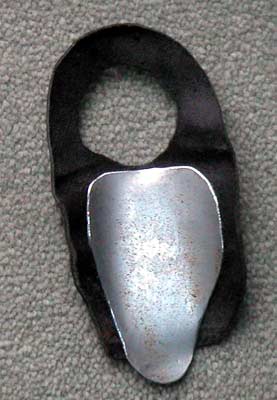Anchoring Off
Some odd bits
Bosun's Chair
Paint
Sailmaker's Palm
Dinghy Spars
Kayak Propulsion
Anchoring Off
My regular method of anchoring off, is by arranging
the right length of warp, flaking it out in a bucket for free
running, making it fast!!, then balance the anchor on the bow.
I then put the bow ashore to disembark, and having tied a tripping
line to the crown of the anchor, I push the boat out. When the
tripping line is almost run out, I give it a tug, which causes
the anchor to drop into the water. When the boat is clearly
lying safely to anchor, I make the tripping line fast on the
shore, making sure that any incoming tide will not cover the
inshore end. When ready to reboard, the tripping line is hauled
ashore, followed by the anchor, and then the boat.
Some odd bits
If you use a drain plug, make sure that you carry
a spare.
If you lock your tiller with a comb device, then
a good one can be made from a toothed rubber timing belt, nailed
flat to a coaming below the tiller.
If you have a permanent mooring, marked with a
buoy, then use a 4ft bit of light line, attached to the underside
of the buoy, with some kind of small float on the end. This
makes life easy when picking up the mooring, and ruins the spectator
sport for onlookers....
Bosun's Chair
Hauling a crew member up the mast rarely applies
in a boat of less than 20 ft, but on occasion I have rigged
a bosun’s chair and hoisted my son up the mast, when he
was younger. I carried a 1 ins thick piece of 20 x 7 ins wood,
which had a vee notch cut into each end. Then I tied a Bowline-on-a-Bight
in a piece of line, put one loop round the boy’s middle
and the piece of wood into the other, for a seat.
Paint
I have used plain black bitumen paint on a clinker
hull, but it does tend to absorb heat, and cause the topsides
to open up and leak a little when heeled. I gather that coloured
bitumen paint is available, even white, which would overcome
that problem. An advantage of bitumen is that it can be applied
to a wet surface, and touching up is possible without it being
obvious.
Sailmaker's Palm
I have had a proper palm for many years, but an
old retired saddler showed me a better tool for the job, which
is a lot cheaper. He took the tongue out of an old pair of boots,
cut a hole for the thumb, and glued a small piece of metal to
the back of it. The needle is pushed through the work by the
leather side, the hand being protected by the metal. Having
used both the bought one and the home made one, I have to say
that the latter is the better tool. The leather prevents the
needle from slipping. The piece of leather is about 3 x 5 ins,
and oval shaped, and the bit of metal is beaten and shaped to
be comfortable on the ball of the thumb.

home made palm
Dinghy Spars
A good source of spars for dinghies is eBay auctions.
I find that there are plenty of sailing surfboard masts and
sails up for grabs, and fashion being what it is, they occasionally
are sold for very cheap prices. I have found 12 ft and 15 ft
masts for only five or six UK Pounds, and once with a sail thrown
in. The more bendy masts would certainly make a good lightweight
sprit, and a surfboard sail would do for a small plywood boat.
The garish colours of the sails are outweighed by the bargain
prices! I would use such a sail with a sprit boom, rigged with
a snotter, not the double wishbone type.
Kayak Propulsion
I have acquired a small kayak, quite beamy, and
while the normal means of propulsion is the use of a double-ended
paddle, it is evident that a pair of oars would be more efficient.
It should be possible to build a sort of A-frame from 2 x 1
ins wood, with a protruding bolt at the apex, which could drop
into a hole on the foredeck, near the bow; with another protruding
bolt in the middle of the cross-piece for a matching hole. The
ends of the side bits would have a 5/8 ins thole pin glued in,
perhaps 3 ins sticking up. The whole thing could easily be made
collapsible, locked by the cross-piece. The thole pins would
need to be about 4 ft apart.
When paddling becomes irksome, then the paddle
could be split into its two halves, a pair of rope strops slipped
on, and, with the stern of the kayak now the bow, the canoeist
would only have to spin the craft round, and pull away.
There is a commercial gadget called the “Oarmaster”
which is far more sophisticated, with a sliding seat etc, and
which has a far more sophisticated price. When this present
chilly weather ends, I shall climb up onto my garage roof and
take measurements, for my prototype...
Next Month: More Miscellaneous Bits


